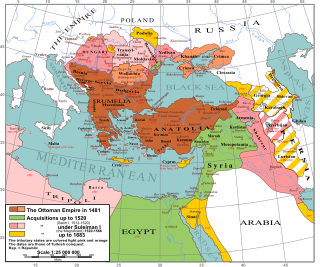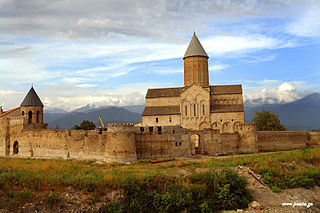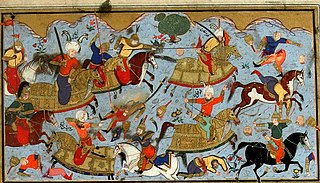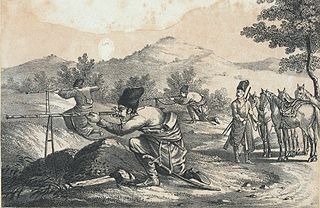 W
WThe Battle of Yeghevārd, also known as the Battle of Baghavard or Morad Tapeh, was the final major engagement of the Perso-Ottoman War of 1730–1735 where the principal Ottoman army in the Caucasus theatre under Koprulu Pasha's command was utterly destroyed by only the advance guard of Nader's army before the main Persian army could enter into the fray. The complete rout of Koprulu Pasha's forces led to a number of besieged Ottoman strongholds in the theatre surrendering as any hope of relief proved ephemeral in light of the crushing defeat at Yeghevārd. One of Nader's most impressive battlefield victories, in which he decimated a force four or five times the size of his own, it helped establish his reputation as a military genius and stands alongside many of his other great triumphs such as at Karnal, Mihmandoost or Kirkuk.
 W
WThe 1534 capture of Baghdad by Suleiman the Magnificent of the Ottoman Empire from the Safavid dynasty under Tahmasp I was part the Ottoman–Safavid War of 1532 to 1555, itself part a series of Ottoman–Persian Wars. The city was taken without resistance, the Safavid government having fled and leaving the city undefended. Baghdad's capture was a significant achievement given its mastery of the Tigris and Euphrates rivers and their international and regional trade. It represented, along with the fall of Basra in 1546, a significant step towards eventual Ottoman victory and the procurement of the lower Mesopotamia, the mouths of the Euphrates and Tigris rivers, opening a trading outlet into the Persian Gulf. The Ottomans wintered there until 1535, overseeing the reconstruction of Sunni and Shia religious shrines and agricultural irrigation projects. Suleiman returned to Constantinople, leaving a strong garrison force. Over the next few decades, the Ottomans solidified their control over the region, incorporating it into their empire until it was recaptured by the Persians in 1623.
 W
WThe siege of Baghdad (1733) was a relatively short but intense siege of Ottoman-held Baghdad by the Persian army under Nader. The outcome was determined not at Baghdad but ultimately far to the north near Samara where a large relief force commanded by the Topal Pasha inflicted a decisive defeat on Nader's Persian army. The Persian besiegers were forced away with the loss of most of their equipment and saving a much exhausted garrison desperate for relief.
 W
WThe Bakhtrioni uprising was a general revolt in the eastern Georgian Kingdom of Kakheti against the political domination of Safavid Persia, in 1659. It is named after the main battle, which took place at the fortress of Bakhtrioni.
 W
WThe Battle of Mollahasanli is a battle that took place on 28 November 1578 during the Ottoman–Safavid War (1578–1590) in the town of Mollahasanli on the banks of the Agsu River in Shirvan. The Safavid army, under the commandment of the Crown Prince Hamza Mirza, defeated the army of the Ottoman ally, the Crimean Khan, under the command of the kalga Adil Giray. Adil Giray himself was taken prisoner.
 W
WThe recapture of Baghdad was the second conquest of the city by the Ottoman Empire as a part of the Ottoman–Safavid War of 1623–1639.
 W
WThe capture of Tabriz from the Ottoman Turks by the Safavid army of Shah Abbas I took place on October 21, 1603, after twenty days fighting during the Ottoman–Safavid War (1603–1618).
 W
WThe Caucasus Campaign of 1734–1735 was the last great campaign of the Ottoman–Persian War (1730–35) which ended in a Persian victory allowing Nader to recast Persian hegemony over almost the entire Caucasus, region, reconconquering it for the Safavid state.
 W
WThe Battle of Chaldiran took place on 23 August 1514 and ended with a decisive victory for the Ottoman Empire over the Safavid Empire. As a result, the Ottomans annexed Eastern Anatolia and northern Iraq from Safavid Iran. It marked the first Ottoman expansion into Eastern Anatolia, and the halt of the Safavid expansion to the west. The Chaldiran battle was just the beginning of 41 years of destructive war, which only ended in 1555 with the Treaty of Amasya. Though Mesopotamia and Eastern Anatolia were eventually reconquered by the Safavids under the reign of Shah Abbas the Great, they would be permanently lost to the Ottomans by the 1639 Treaty of Zuhab.
 W
WThe Battle of Çıldır was fought in 1578 during the Ottoman–Safavid War (1578–1590).
 W
WThe Battle of Damghan or Battle of Mehmandoost was fought on September 29 to October 5, 1729, near the city of Damghan. It resulted in an overwhelming victory for Nader and the Safavid cause he had taken up, though by itself it did not end Ashraf's rule in Iran, it was a significant triumph which led to further successes in the following engagements of the campaign to restore Tahmasp II to the throne. The battle was followed by another one in Murcheh-Khort, a village near Isfahan. Nader's forces were victorious in both battles, which led him to remove the Ghilzai Afghan dynasty from their short stay on the Persian throne. The Hotakis were forced back to their territory in what is now southern Afghanistan.
 W
WThe Battle of Zarghan was the last battle of Ashraf Hotaki's career as a statesman. Having been repeatedly bludgeoned by Nader's army through the Battles of Mihmandoost and Murche-Khort Ashraf had withdrawn from Isfahan and escaped south to Shiraz to rebuild his army in an ultimately futile attempt to reverse his fortunes. Although he found some local support amongst a few of the tribes he was decisively beaten, for the last time, after which he disappeared from Persia as well as the historical records, with no consensus being reached concerning the manner of his demise.
 W
WThe Battle of Gulnabad was fought between the military forces from Hotaki Dynasty and the army of the Safavid Empire. It further cemented the eventual fall of the Safavid dynasty, which had been declining for decades.
 W
WThe Campaign of Herat consisted of a series of intermittent and fluid engagements culminating in the finale of Nader's military operations against the Abdali Afghans. Nader having recently concluded a successful campaign against his own monarch and prince, the badly humiliated Tahmasp II, set out from Mashad on May 4, 1729 making sure the Shah also accompanied him on this journey where he could be kept under close supervision.
 W
WThe Herat Campaign of 1731 took place when Nader Shah who had already successfully driven the Ottomans from western Iran and southern Azerbaijan had to cut his campaign short to deal with the revolt of the Abdalis of Herat who were provoked into bearing arms against their Persian overlords by Hussein Hotaki of Qandahar. The conflict resulted in the re-establishment of Persian rule over Herat.
 W
WThe Battle of Jabani - occurred on October 1500 and ended with a decisive victory for the Safavid Empire over the State of Shirvanshahs.
 W
WThe Siege of Kemah begun in winter and ended on 19 May 1515. Siege ended with a decisive victory for the Ottoman Empire over the Safavid Empire. With this victory, Ottomans created their safe border against the Safavids.
 W
WThe Conquest of Khorasan by Safavid loyalist forces against separatists in Khorasan was Nader's first major military campaign which he waged on behalf of the new Safavid pretender to the throne, Tahmasp II. It would propel him into the centre of the political landscape of war torn early eighteenth century Persia.
 W
WThe Battle of Khwar Pass was a failed ambush set up by Ashraf Hotaki during his retreat in the aftermath of his defeat at Mihmandoost. Gathering what forces lay on his route, Ashraf pulled together another formidable fighting force around the remains of his badly bloodied force, even having enough men to spare for an ambush set up at a narrow pass east of Varamin.
 W
WThe Battle of Kirkuk, also known as the Battle of Agh-Darband, was the last battle in Nader Shah's Mesopotamian campaign where he avenged his earlier defeat at the hands of the Ottoman general Topal Osman Pasha, in which Nader achieved suitable revenge after defeating and killing him at the battle of Kirkuk. The battle was another in the chain of seemingly unpredictable triumphs and tragedies for both sides as the war swung wildly from the favour of one side to the other. Although the battle ended in a crushing victory for the Persians, they had to be withdrawn from the area due to a growing rebellion in the south of Persia led by Mohammad Khan Baluch. This rebellion in effect robbed Nader of the strategic benefits of his great victory which would have included the capture of Baghdad, if he had the chance to resume his campaign.
 W
WThe Battle of Koçhisar took place on May 1516 nearby Kızıltepe and ended with a decisive victory for the Ottoman Empire over the Safavid Empire. It marked the halt of the Safavid expansion to the west. The Koçhisar battle was just the one of 41 years of destructive war, which only ended in 1555 with the Treaty of Amasya. Safavid commander Karahan Ustajlu killed at the battlefield and his most of men slaughtered by the Ottomans.
 W
WLala Mustafa Pasha's Caucasian campaign was a military expedition launched in 1578 by Lala Mustafa Pasha, a grand-vizier of the expanding Ottoman Empire. It is also considered a part of the larger conflict, Ottoman–Safavid War (1578–90).
 W
WThe liberation of Isfahan was a direct result of the Battle of Murche-Khort in which the Persian army under Nader attacked and routed Ashraf's Afghan army. The day after Murche-Khort on November 16, 1729 Nader marched his army into Isfahan where the looting and mob violence that had gripped the city in the chaotic aftermath of Ashraf's departure ceased immediately. Order was restored with many of the Afghans hiding throughout the city being dragged through the streets and massacred without mercy in reprisals. The tomb of Mahmud Hotaki was also another target of the mob's rage, being demolished and later becoming home to a public toilet.
 W
WThe Battle of Marabda took place on 30 June 1625, or July 1, 1625, when the Iranian Safavid army defeated a Georgian force. This battle occurred after the Battle of Martqopi in the same year, when the Iranian army was routed.
 W
WThe Battle of Merv occurred on 2 December 1510 as a result of the Uzbek invasion of Khorasan. It ended with a decisive victory for the Safavid dynasty. The result was that the Safavids regained control of the Khorasan region.
 W
WThe Battle of Murche-Khort was the last decisive engagement of Nader's campaign to restore Tahmasp II to the Persian throne. Ashraf had failed to arrest Nader's advance onto Isfahan at Khwar pass where his ambush was discovered, surrounded and ambushed itself. The battle was fought in an uncharacteristic manner by the Afghans who to some extent sought to replicate their foes tactical systems which had so badly devastated their armies up to this point. Victory opened a clear road south towards Isfahan and the return of Safavid rule for a few brief years before Nader himself would overthrow it.
 W
WThe Mesopotamian Campaign of 1732-1733 was a military conflict during the eventful Perso-Ottoman war of 1730-1735. As a direct result of Tahmasp II's blunders in his ill fated invasion of the Ottoman Caucasus all of Nader's previous gains in the theatre were lost and a humiliating treaty had been signed giving away hegemony over the Caucasus to Istanbul. This settlement gave Nader the authority to force Tahmasp's abdication and resume the war against the Turks by launching an invasion of Ottoman Iraq.
 W
WThe Capture of Ormuz was a combined Anglo-Persian expedition that successfully captured the Portuguese garrison at Hormuz Island after a ten-week siege, thus opening up Persian trade with England in the Persian Gulf. Before the capture of Ormuz, the Portuguese had held the Castle of Ormuz for more than a century, since 1507 when Afonso de Albuquerque established it in the capture of Ormuz, giving them full control of the trade between India and Europe through the Persian Gulf. According to Stephen Neill, the capture of Ormuz entirely changed the balance of power and trade.
 W
WThe Capture of Ormuz in 1507 occurred when the Portuguese Afonso de Albuquerque attacked Hormuz Island to establish the Fortress of Ormuz. This conquest gave the Portuguese full control of the trade between India and Europe passing through the Persian Gulf.
 W
WThe Sabzevar expedition was a politically decisive event in Nader's career where he in effect turned from mere commander-in-chief of Tahmasp's forces into the real power behind the throne. The expedition was launched mainly due to Tahmasp's own incompetence and ill-thought attempt at curbing the powers of his upstart general and military genius.
 W
WThe Battle of Samarra was the key engagement between the two great generals Nader Shah and Topal Osman Pasha, which led to the siege of Baghdad being lifted, keeping Ottoman Iraq under Istanbul's control. The armed contest between the two colossi was very hard fought with a total of roughly 50,000 men becoming casualties by the end of the fighting that left the Persians decimated and the Ottoman victors badly shaken. Other than its importance in deciding the fate of Baghdad, the battle is also significant as Nader's only battlefield defeat although he would avenge this humiliation at the hands of Topal Pasha at the battle of Agh-Darband where Topal was killed.
 W
WThe siege of Isfahan was a six-month-long siege of Isfahan, the capital of the Safavid dynasty of Iran, by the Hotaki-led Afghan army. It lasted from March to October 1722 and resulted in the city's fall and the beginning of the end of the Safavid dynasty.
 W
WThe Siege of Tabriz took place in 1501 just after the Safavids had defeated the Aq Qoyunlu in the Battle of Sarur. In the preceding battle the Aq Qoyunlus army was 4 times bigger than the Safavid army. After the siege Ismail I chose Tabriz as his capital and proclaimed himself Shahanshah of Iran.
 W
WThe siege of Van occurred in 1548 when Suleiman the Magnificent attacked Persia in his second campaign of the Ottoman-Safavid War (1532–1555).
 W
WThe campaign of 1731 was a failed attempt by Tahmasp II of the Safavid dynasty to launch an offensive into Ottoman held Caucasus which ended in a disastrous defeat with all of Nader's gains during the previous year being lost. The result of this particular military catastrophe was still overturned with Nader's return from the east but would have much more significant impact on the Safavid dynasty itself as Tahmasp II sealed his own fate by initiating this ill fated expedition.
 W
WThe Battle of Tekiryaylağı took place on Summer 1515 nearby Ovacık, Tunceli and ended with a decisive victory for the Ottoman Empire over the Safavid Empire. It marked the halt of the Safavid offensive over the North Anatolia. The Tekiryaylağı battle was just the one of 41 years of destructive war, which only ended in 1555 with the Treaty of Amasya. Safavid commander Nur-Ali Khalifa as well as most of his troops were killed at the battlefield. But Aykutoğlu Bey survived.
 W
WThe Battle of Urmia was fought near Lake Urmia in north-western Persia between the Safavid and Ottoman empires and resulted in a decisive Safavid victory. The Ottomans were fooled into an ambush where many of them were killed or captured in an encirclement manoeuvre. Over the next three years all of western and northern Persia was recaptured and the Safavids even re-established their suzerainty over their former vassals in the Caucasus.
 W
WNader's Western Persia campaign of 1730 was his first against perhaps his most formidable of adversaries, namely the Ottomans, where he proved triumphant in conquest. The great successes of his expedition, however, were rendered null when Shah Tahmasp II decided to take personal command of the theatre in Nader's absence, forcing a furious Nader to return and rectify the situation after forcing Tahmasp's abdication in favour of his infant son Abbas III.